Blog
Learning Materials
Image in Text Citation Guide 2025: Academic Best Practices
Updated: July 3, 2025
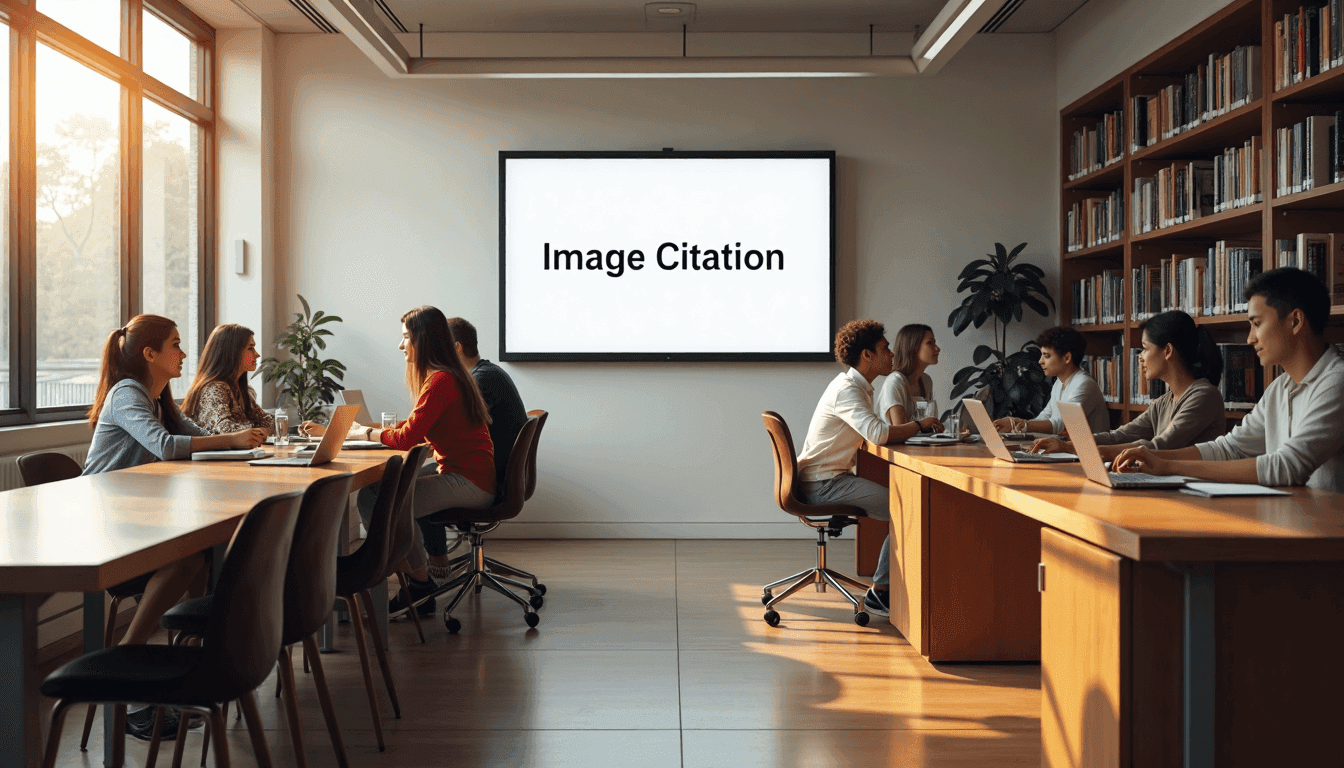
Image citation is not just a formality in academic writing. Almost half of academic misconduct cases involve incorrect or missing visual source attributions. Think you can just copy visuals and slap a credit underneath? That habit could put your entire research at risk and even lead to penalties. The real secret is that citing images the right way is about protecting your credibility and future in academia.
Table of Contents
- Understanding Image In Text Citation Rules Dockerfile README.md email-templates i18n-config.ts i18nConfig.ts next-sitemap-samwell.config.js next-sitemap-semihuman.config.js next.config.js node_modules package-lock.json package.json process_content.js public scripts src svgr.d.ts translations tsconfig.json Core Principles Of Image Citation Dockerfile README.md email-templates i18n-config.ts i18nConfig.ts next-sitemap-samwell.config.js next-sitemap-semihuman.config.js next.config.js node_modules package-lock.json package.json process_content.js public scripts src svgr.d.ts translations tsconfig.json Digital And AI Image Citation Challenges
- How To Cite Images In Different Styles Dockerfile README.md email-templates i18n-config.ts i18nConfig.ts next-sitemap-samwell.config.js next-sitemap-semihuman.config.js next.config.js node_modules package-lock.json package.json process_content.js public scripts src svgr.d.ts translations tsconfig.json APA Style Image Citation Techniques Dockerfile README.md email-templates i18n-config.ts i18nConfig.ts next-sitemap-samwell.config.js next-sitemap-semihuman.config.js next.config.js node_modules package-lock.json package.json process_content.js public scripts src svgr.d.ts translations tsconfig.json MLA And Chicago Style Visual Source References Dockerfile README.md email-templates i18n-config.ts i18nConfig.ts next-sitemap-samwell.config.js next-sitemap-semihuman.config.js next.config.js node_modules package-lock.json package.json process_content.js public scripts src svgr.d.ts translations tsconfig.json Emerging Challenges In Digital Image Citation
- Common Mistakes And How To Avoid Them Dockerfile README.md email-templates i18n-config.ts i18nConfig.ts next-sitemap-samwell.config.js next-sitemap-semihuman.config.js next.config.js node_modules package-lock.json package.json process_content.js public scripts src svgr.d.ts translations tsconfig.json Misattribution And Incomplete Source Information Dockerfile README.md email-templates i18n-config.ts i18nConfig.ts next-sitemap-samwell.config.js next-sitemap-semihuman.config.js next.config.js node_modules package-lock.json package.json process_content.js public scripts src svgr.d.ts translations tsconfig.json Digital And AI Image Citation Challenges Dockerfile README.md email-templates i18n-config.ts i18nConfig.ts next-sitemap-samwell.config.js next-sitemap-semihuman.config.js next.config.js node_modules package-lock.json package.json process_content.js public scripts src svgr.d.ts translations tsconfig.json Navigating Style Guide Inconsistencies
- Tips For Citing Figures, Charts, And Tables Dockerfile README.md email-templates i18n-config.ts i18nConfig.ts next-sitemap-samwell.config.js next-sitemap-semihuman.config.js next.config.js node_modules package-lock.json package.json process_content.js public scripts src svgr.d.ts translations tsconfig.json Standardized Formatting And Numbering Dockerfile README.md email-templates i18n-config.ts i18nConfig.ts next-sitemap-samwell.config.js next-sitemap-semihuman.config.js next.config.js node_modules package-lock.json package.json process_content.js public scripts src svgr.d.ts translations tsconfig.json Discipline-Specific Citation Approaches Dockerfile README.md email-templates i18n-config.ts i18nConfig.ts next-sitemap-samwell.config.js next-sitemap-semihuman.config.js next.config.js node_modules package-lock.json package.json process_content.js public scripts src svgr.d.ts translations tsconfig.json Advanced Considerations For Digital And Adapted Visuals
Quick Summary
| Takeaway | Explanation |
|---|---|
| Core principles of image citation are crucial | Proper documentation of visual sources prevents plagiarism and maintains academic integrity, requiring elements such as creator's name, publication year, and image title. |
| AI-generated images require new citation considerations | Researchers must document the AI tool used and the specific prompt for AI-generated visuals to ensure transparency. |
| Different styles demand precision in citation | Understanding the nuances of APA, MLA, and Chicago styles is vital, as each has distinct formatting requirements for visual sources. |
| Common citation mistakes to avoid | Errors like misattributing images or omitting key source details can compromise academic credibility and lead to penalties. |
| Discipline-specific guidelines should be followed | Each academic field has unique requirements for citing visual sources; adherence to these enhances scholarly communication. |
Understanding Image in Text Citation Rules
Image in text citation represents a critical academic skill that ensures proper credit and intellectual integrity when incorporating visual materials into research papers and scholarly documents. Researchers and students must navigate complex guidelines that vary across different citation styles while maintaining clear attribution for visual sources.
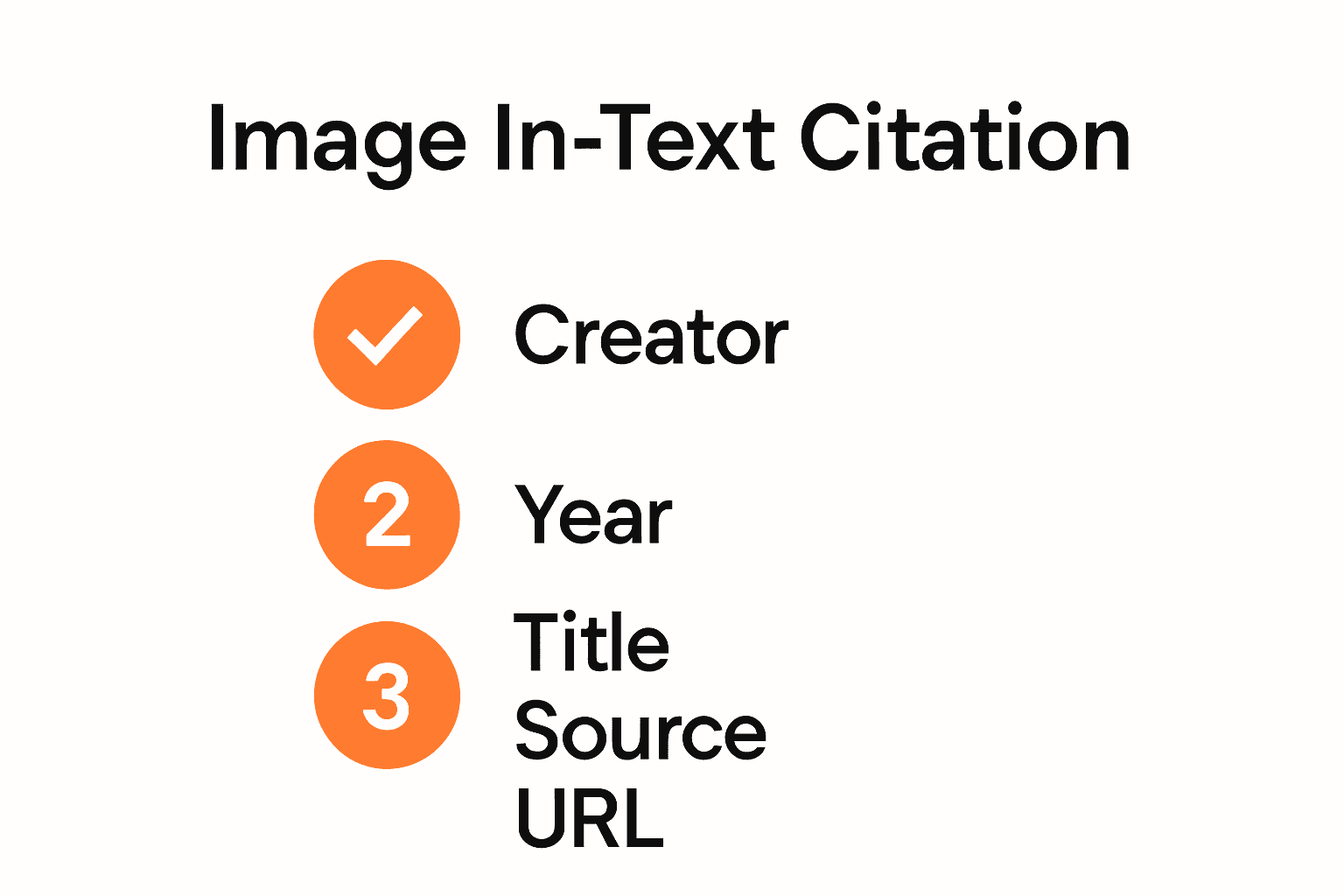
Core Principles of Image Citation
Understanding image citation requires mastering several fundamental principles. Academic institutions demand precise documentation of visual sources to prevent plagiarism and provide readers with comprehensive research context. Learn more about citation fundamentals to enhance your academic writing skills.
When citing images, researchers must include specific elements that comprehensively identify the visual source. According to the American Psychological Association, these elements typically include:
- Creator's name: The original artist or photographer
- Publication year: When the image was created or published
- Image title: Official or descriptive title of the visual work
- Source information: Where the image was originally published or accessed
- URL or digital identifier: For digital or online images
Digital and AI Image Citation Challenges
The emergence of AI-generated images has introduced new complexities in academic citation practices. Research from Harvard University suggests that AI-generated visual content requires special citation considerations. Researchers must now document not just the image itself but also the generative tool and specific prompt used to create the visual material.
For instance, when citing an AI-generated image, an academic paper might include a notation like: "Figure 1. AI-generated image created using [specific AI tool] with the prompt: [exact generative instructions]." This approach provides transparency about the image's origin and creation process.
Modern citation guidelines recommend different approaches depending on the academic discipline and specific style guide. The APA 7th edition, for example, provides explicit instructions for citing digital and AI-generated images, emphasizing the importance of providing comprehensive context for visual sources.
Researchers must remain adaptable as citation practices continue evolving with technological advancements. Staying informed about the latest citation guidelines ensures academic integrity and proper attribution in scholarly work. By understanding these nuanced rules, students and researchers can effectively integrate visual materials into their academic documents while maintaining rigorous documentation standards.
How to Cite Images in Different Styles

Citing images across different academic styles requires precision and attention to specific formatting guidelines. Researchers must understand the nuanced requirements of various citation systems to ensure accurate and comprehensive visual source documentation. Read our guide on citation fundamentals to build a strong foundation in academic referencing.
APA Style Image Citation Techniques
The American Psychological Association (APA) style provides detailed guidelines for image citations. According to Yale University Library, APA 7th edition requires a comprehensive approach to visual source documentation. When citing an image, researchers must include:
- Creator's full name
- Publication year
- Complete image title
- Image type (photograph, painting, digital illustration)
- Source or repository
- Digital identifier or URL
For example, a typical APA image citation might look like: Smith, J. (2022). Urban Landscape at Sunset [Photograph]. Getty Images. https://www.gettyimages.com/detail/photo.
MLA and Chicago Style Visual Source References
Research from the Modern Language Association highlights distinct approaches to image citations. MLA style emphasizes the creator's name, work title, and publication details. Chicago style offers more flexibility, allowing for footnote or bibliography entries depending on the specific academic context.
Key differences between MLA and Chicago image citation styles include:
- MLA prioritizes creator name and work title
- Chicago allows more detailed contextual information
- Placement of publication details varies between styles
- Digital source identification requires specific formatting
Below is a table comparing the main features and differences between APA, MLA, and Chicago image citation styles to help you quickly reference their core requirements.
| Style Guide | Key Elements Required | Placement of Publication Details | Flexibility/Notes |
|---|---|---|---|
| APA | Creator's full name, year, image title, image type, source/repository, URL/identifier | End of citation (reference) | Structured and comprehensive requirements |
| MLA | Creator's name, work title, publication details, medium, URL (if online) | After title | Prioritizes author and title, less on format |
| Chicago | Creator's name, title, year, context/source, additional notes, URL if digital | Footnote or bibliography | Flexible, supports footnotes or endnotes |
Emerging Challenges in Digital Image Citation
The rise of AI-generated and digital images has created new challenges for academic citation. Harvard University's research suggests that researchers must now account for additional elements such as:
- AI tool used for image generation
- Specific generative prompt
- Date of AI image creation
- Platform or software used
Academic institutions are rapidly developing guidelines to address these emerging citation challenges. Researchers must stay adaptable and informed about the latest best practices in visual source documentation.
Navigating the complex landscape of image citations requires careful attention to detail and a thorough understanding of different academic style guides. By mastering these citation techniques, researchers can ensure proper attribution and maintain the highest standards of academic integrity in their visual source references.
Common Mistakes and How to Avoid Them
 Image citation requires meticulous attention to detail, and even experienced researchers can inadvertently make critical errors that compromise academic integrity. Explore our comprehensive citation basics to strengthen your academic writing skills and avoid potential pitfalls.
Image citation requires meticulous attention to detail, and even experienced researchers can inadvertently make critical errors that compromise academic integrity. Explore our comprehensive citation basics to strengthen your academic writing skills and avoid potential pitfalls.
Misattribution and Incomplete Source Information
One of the most significant challenges in image citation is providing comprehensive and accurate source information. According to Columbia University's Research Guidelines, researchers frequently make mistakes such as:
- Omitting the creator's full name
- Failing to include the precise publication date
- Neglecting to specify the image type (photograph, digital illustration, painting)
- Incomplete source or repository information
- Incorrect URL or digital identifier
These omissions can lead to significant credibility issues. Research from the University of Cambridge suggests that incomplete citations can be considered a form of academic misconduct, potentially resulting in penalties for students and researchers.
To help you identify and avoid common citation mistakes, here's a checklist table summarizing frequent errors and their impact:
| Common Mistake | Description | Academic Impact |
|---|---|---|
| Omitting creator's full name | Not providing the complete name of image creator | Loss of source traceability |
| Missing publication date | Failure to specify when the image was published | Undermines temporal context |
| Excluding image type | Not clarifying if it’s a photograph/painting/etc. | Ambiguity about visual resource |
| Incomplete source/repository information | Partial or missing publication/source details | Hinders verification of image |
| Incorrect or missing URL/digital identifier | Leaving out or miswriting link for digital images | Reader cannot access source |
Digital and AI Image Citation Challenges
The emergence of AI-generated images has introduced complex new citation challenges. Harvard University's Digital Scholarship Guide highlights several critical mistakes researchers make when citing AI-generated visual content:
- Failing to acknowledge the AI tool used
- Not documenting the specific generative prompt
- Omitting the date of AI image creation
- Treating AI-generated images identically to traditional images
Researchers must develop nuanced approaches to documenting these emerging visual sources. For instance, an AI image citation might require additional context about the generative process, tool, and specific parameters used to create the visual material.
Navigating Style Guide Inconsistencies
Different academic disciplines and publications maintain unique citation requirements. Researchers often struggle with:
- Mixing citation styles within a single document
- Incorrectly applying punctuation and formatting
- Misunderstanding style-specific nuances
- Failing to update citations according to the latest style guide revisions
Professional academic writers recommend maintaining a consistent reference approach and regularly consulting the most recent style guide updates. Attention to these details demonstrates scholarly rigor and commitment to academic excellence.
Mastering image citation requires ongoing learning and adaptability. By understanding common pitfalls and developing a systematic approach to documenting visual sources, researchers can maintain the highest standards of academic integrity and ensure their work meets professional scholarly requirements.
Tips for Citing Figures, Charts, and Tables
Citing figures, charts, and tables requires precision and careful attention to academic guidelines. Explore our comprehensive research citation basics to enhance your understanding of visual source documentation.
Standardized Formatting and Numbering
Accurate visual source citation begins with consistent formatting and systematic numbering. According to Harvard University's Academic Publishing Guidelines, researchers must adhere to several critical principles:
- Number figures and tables sequentially throughout the document
- Use clear, descriptive titles for each visual element
- Include comprehensive source information beneath each figure
- Ensure all visual elements are directly referenced in the text
- Maintain consistent formatting across all visual citations
Research from the University of Cambridge emphasizes that each visual element should include:
- Precise numbering (Figure 1, Table 2)
- Descriptive title in italics
- Complete source attribution
- Copyright information if applicable
Discipline-Specific Citation Approaches
Different academic disciplines have unique requirements for visual source citation. Columbia University's Research Communication Center highlights key variations:
- Scientific disciplines often require more technical, data-driven captions
- Humanities fields emphasize contextual information and interpretative details
- Social sciences blend quantitative and qualitative citation approaches
- STEM fields prioritize precise mathematical and statistical annotations
Advanced Considerations for Digital and Adapted Visuals
Modern academic research increasingly involves complex visual sources, including digital graphics and adapted materials. MIT's Digital Scholarship Guide recommends:
- Clearly indicate if a figure is original or adapted from another source
- Provide full citation for reproduced or modified visual elements
- Include specific details about digital generation or modification
- Document software or tools used in creating or modifying visual content
- Obtain necessary permissions for reproduced materials
Researchers must navigate increasingly complex visual citation landscapes. AI-generated graphics, digital adaptations, and interdisciplinary research demand sophisticated citation strategies that balance technical accuracy with comprehensive attribution.
Mastering the art of citing figures, charts, and tables requires continuous learning and adaptability. By developing a systematic approach to visual source documentation, researchers can effectively communicate their findings while maintaining the highest standards of academic integrity.
Frequently Asked Questions
What are the core principles of image citation in academic writing?
Proper image citation involves documenting elements such as the creator's name, publication year, image title, source information, and a URL or digital identifier. This ensures intellectual integrity and prevents plagiarism.
How do I cite AI-generated images?
To cite AI-generated images, include details about the AI tool used, the specific prompt employed, and the date of creation. This provides transparency about the origin and creation process of the visual content.
What are the differences between APA, MLA, and Chicago citation styles for images?
APA requires comprehensive documentation, including the image type, while MLA emphasizes creator name and work title. Chicago style offers flexibility with footnotes or bibliography entries based on context.
What are common mistakes to avoid when citing images?
Common mistakes include misattributing images, omitting essential details like the creator’s name or publication date, and misformatting citations according to the designated style guide.
Confidently Master Image Citations with Samwell.ai
Struggling with the stress and uncertainty of image citation in your academic work? It is easy to feel overwhelmed by constantly changing rules and the fear of making a costly mistake. You now know from our guide how missing just one element or failing to address AI-generated visuals can put your academic credibility at risk. Even experts risk penalties when citations fall short. What if you could remove the guesswork and guarantee your research meets current standards every time?
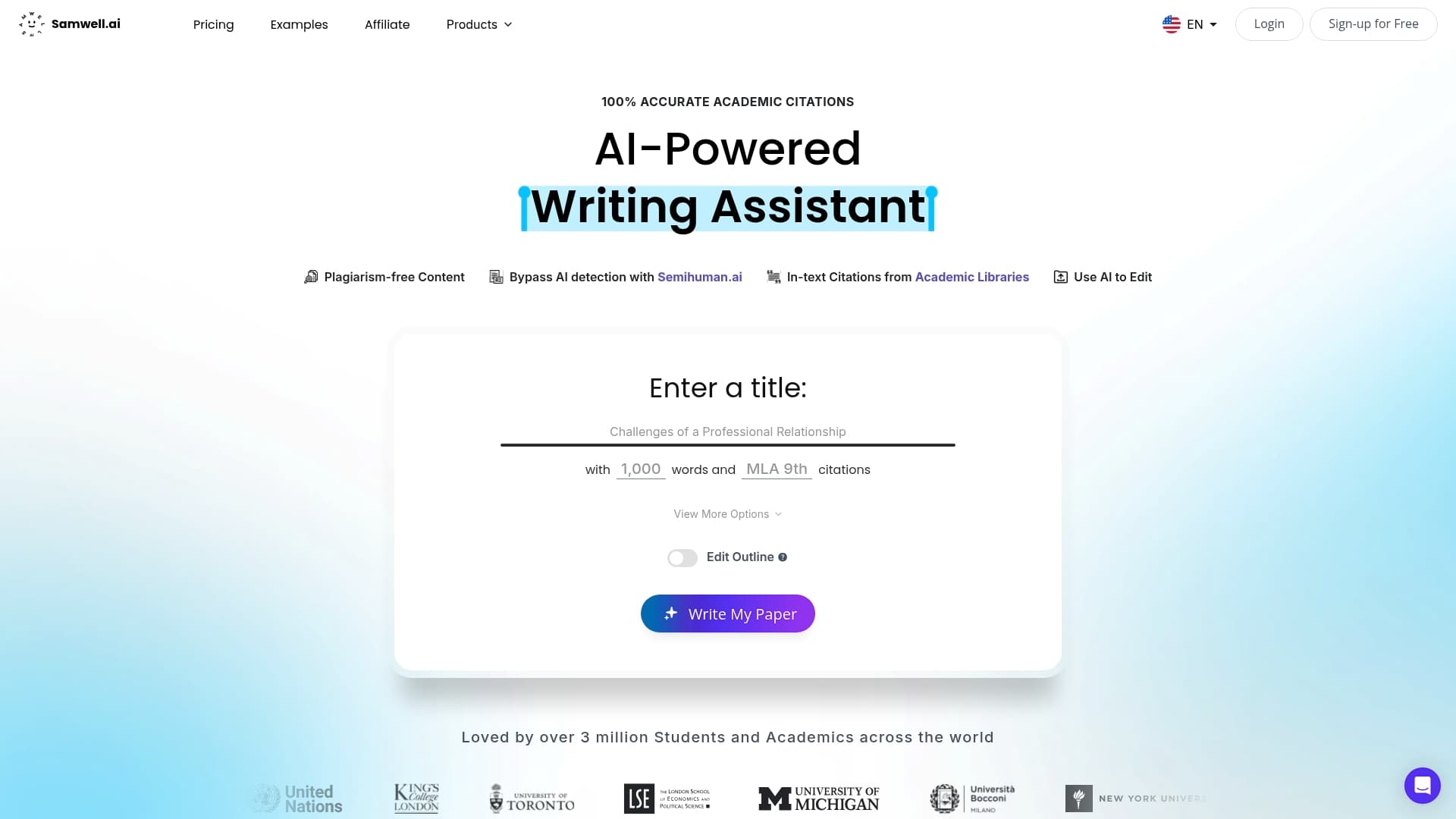
Let Samwell.ai be your trusted partner. Our technology checks every detail from image credit lines to complex APA or MLA formatting. It even helps you cite AI-generated graphics with total confidence while protecting you from accidental plagiarism. Join over a million users who choose Samwell.ai to write and enhance academic work with full compliance and originality. Start your next paper knowing your visuals are correctly cited and your reputation is secure. Visit Samwell.ai now to see how easy citing images should be.
Recommended
Generate essays with Samwell.ai
Whether you’re a publisher, professor, journalist, or student, let us tailor a plan just for you.Most Read Articles
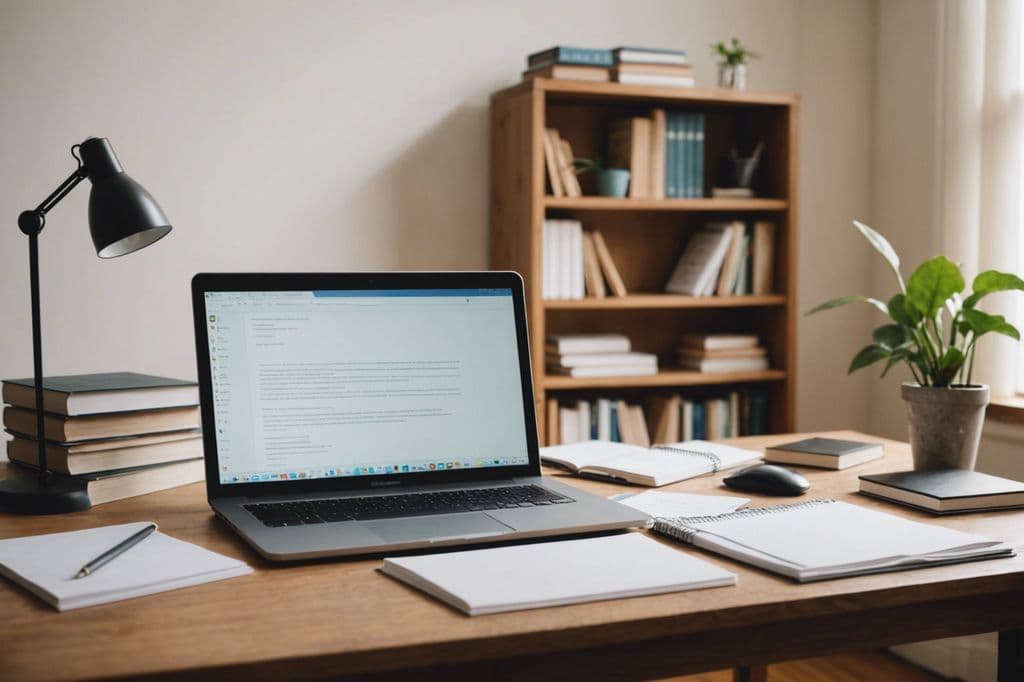
Your Guide to Help Writing a Essay Successfully
Expert tips for help writing a essay - from crafting a thesis to structuring your essay effectively.

How to Write Critical Thinking Essay: Expert Tips
Expert tips for writing a critical thinking essay. Learn how to structure, choose topics, and use evidence effectively.'
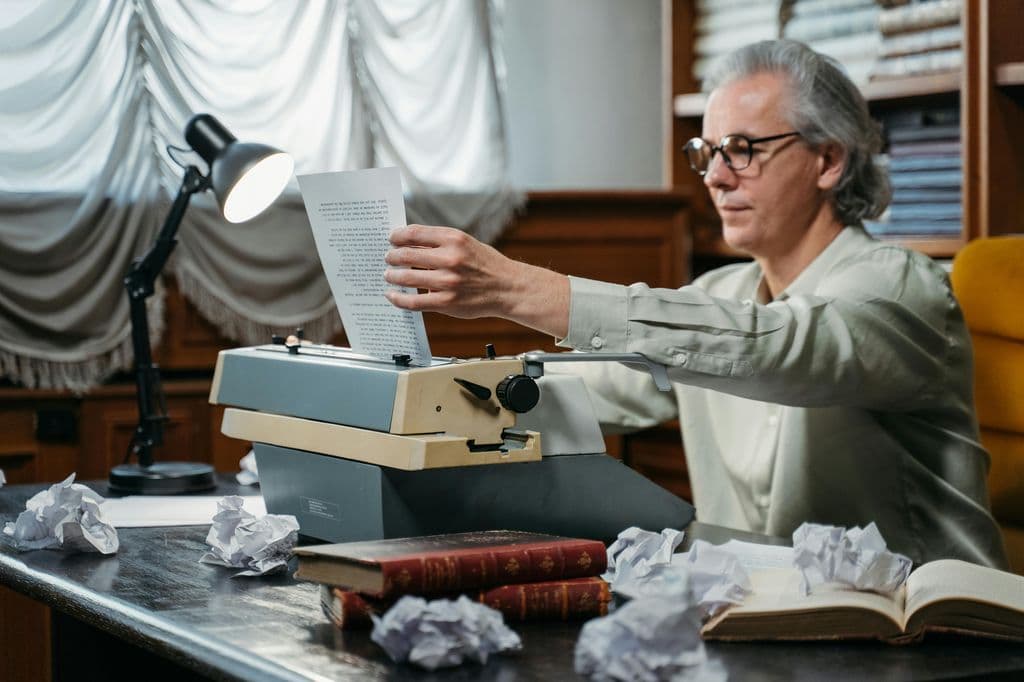
How to Write a Good Hook: A Step-by-Step Guide
Master the art of crafting a good hook with our guide. Create compelling openers for a memorable first impression.
